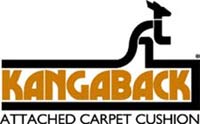Kanga Carpet

What is Carpet with Attached Backing?
'KANGA' is a family name for a series of patented polyurethane attached cushion carpets. Unlike old black foam rubber backs, or cheap imitations, Kanga will not peel or crumble. Carpet tiles can be easier to install and maintain than rolled carpet, offer versatile design options and can be highly stain resistant. Carpet tiles have more visible seams compared to carpet rolls, can be more expensive and be unsuitable for areas prone to mold or mildew. We also carry commercial carpet.
- Made of 100% premium polyurethane foam, Kanga cushions provide carpets with a soft, luxurious feel.
- “KANGA” is a family name for a series of patented polyurethane attached cushion carpets.
- Carpet manufactured with polyurethane attached backing/cushion has stood the test of time beautifully, acquiring a remarkable reputation for performance and comfort.
What is Carpet with Attached Backing for?
- Insulation for feet on a cold tile or concrete floor.
- Making a room more comfortable, more inviting to sit on the floor (e.g. children’s playroom).
- You can easily install Kanga attached cushion carpets yourself.
- Reducing the noise from walking, especially useful on upper floors, and in apartment buildings.
- Adding colour or decoration to a room.
Check out our current and on-going specials for carpet with attached backing!
What makes Carpet with Attached Backing unique?
- Kanga helps absorb the punishment of foot traffic that causes your carpet’s face fiber to mat and crush. The result is that your carpet will look better for longer.
- Resistant to most household cleaning supplies. Its moisture resistance makes the clean-up of spills much easier than with conventional carpet.
- Resists mold, mildew or bacteria, making it an excellent choice for any damp or below grade installations.
- “Easy Release” outer skin layer allows for a cleaner removal with less of the crumbly mess left by conventional type cushions.
- They are incredibly light, making them easy to handle. With a few simple, inexpensive tools and double-face tape you can complete a beautiful, quality installation in no time.
What are some technical details?
- Carpet is commonly made in widths of 12 feet (3.7 m) and 15 feet (4.6 m) in North America.
- Fixed to a floor over a cushioned underlay (pad) using nails, tack strips, adhesives, or occasionally decorative metal stair rods.
- Fibres are chosen for durability, appearance, ease of manufacture, and cost.
- In production, the dominant materials are polyamides (nylons) and polypropylene with an estimated 90% of the commercial market.
Nylon
- Is one of the most common materials in the construction of carpets.
- Nylon can be printed easily and has excellent wear characteristics.
- Due it’s excellent wear-resistance, nylon is widely used in industrial and commercial carpeting.
Polypropylene
- Commonly used to construct berber carpets.
- Commercial grade styles wear very well, making them very suitable for areas with heavy foot traffic such as offices.
- Polypropylene carpets are known to have good stain resistance, but not against oil-based agents.
Polyester
- The polyester known as “PET” is used in carpet manufacturing for both spun and filament constructions.
- When the price of raw materials for many types of carpet rose in the early 2000s, polyester became more competitive.
- Has good physical properties and is inherently stain-resistant because it is hydrophobic.
- A disadvantage is it tends to crush or mat down easily. It is typically used in mid- to low-priced carpeting.
- Another polyester, “PTT”, also called Sorona or 3GT (Dupont) or Corterra (Shell), is a variant of PET. These carpet fibers have resiliency comparable to nylon.
Acrylic
- A synthetic material first created by the Dupont Corporation in 1941 but has gone through various changes since it was first introduced.
- In the past, acrylic carpet used to fuzz or “pill” easily. This happened when the fibres degraded over time and short strands broke away with contact or friction.
- New types of acrylics have been developed to alleviate some of these problems.
- Acrylic is colourfast, washable, and has the feel and appearance of wool, making it a good rug fabric.
Information adapted from Wikipedia and Kanga
Due to our recent proprietary machiney built by innovative engineers, Nance Industries is able to offer affordable private label lines of residential carpet tile to consumers everywhere. If you are a retailer looking to create your own private label line of residential carpet tile for your store, contact us.
Kanga Carpet With Attached Pad
DIY Residential Carpet Tile
Designed for the Do It Yourself customer, these residential carpet tiles are soft and very easy to install. Carpeting your room has never been easier-simply peel & stick. Each residential carpet tile has a 1/4' Kanga Hyde padding that will give your carpet tile a soft cushion underneath your feet. Made with stain proof yarn fibers, this residential carpet tile will hold up even to the toughest of stains. These carpet fibers will not fade or wear out overtime, keeping your room fresh and new.
Premium DIY Residential Carpet Tile
Our premium DIY residential carpet tiles carry a heavy 26 oz face weight and are backed with 1/4” Kanga Hyde polyurethane padding to provide premium comfort and support to your floors. These carpet tiles are both backed with a lifetime stain and fade resistant warranty, so you can rest easy knowing your floors are protected.
Where To Buy Kanga Carpet
Copyright Nance Industries Corporation. 2020 All Rights Reserved.